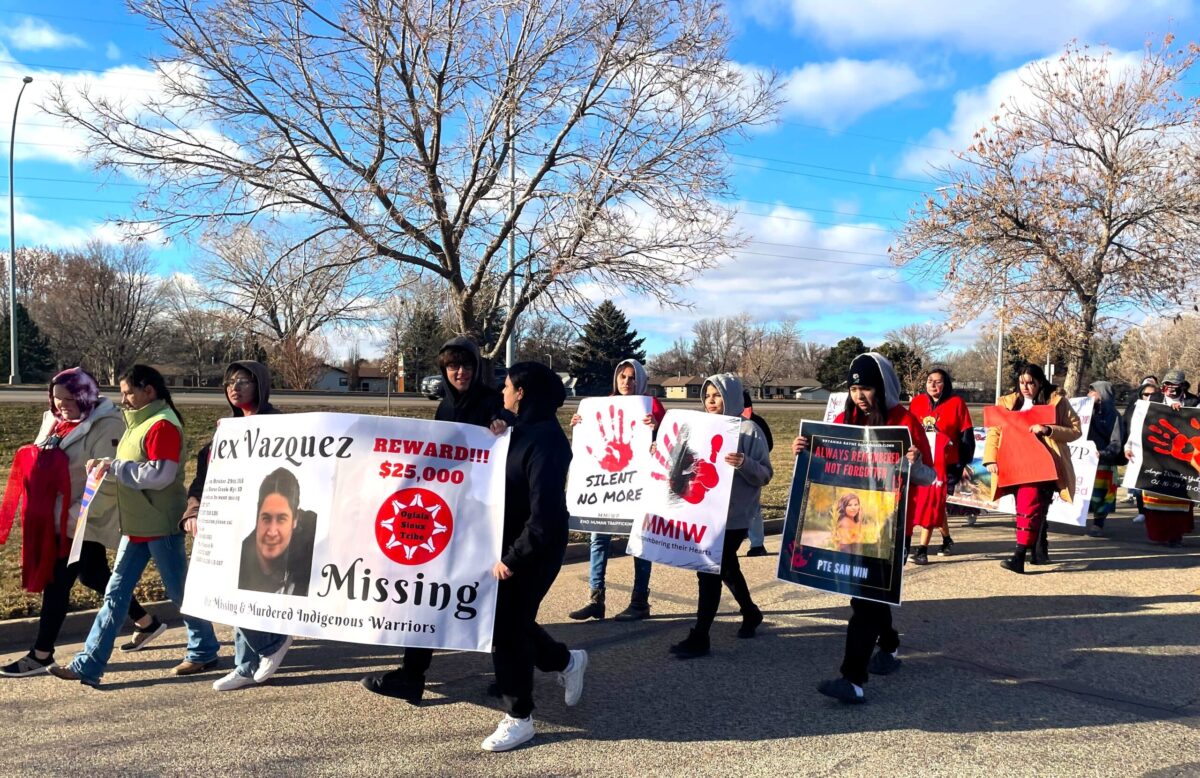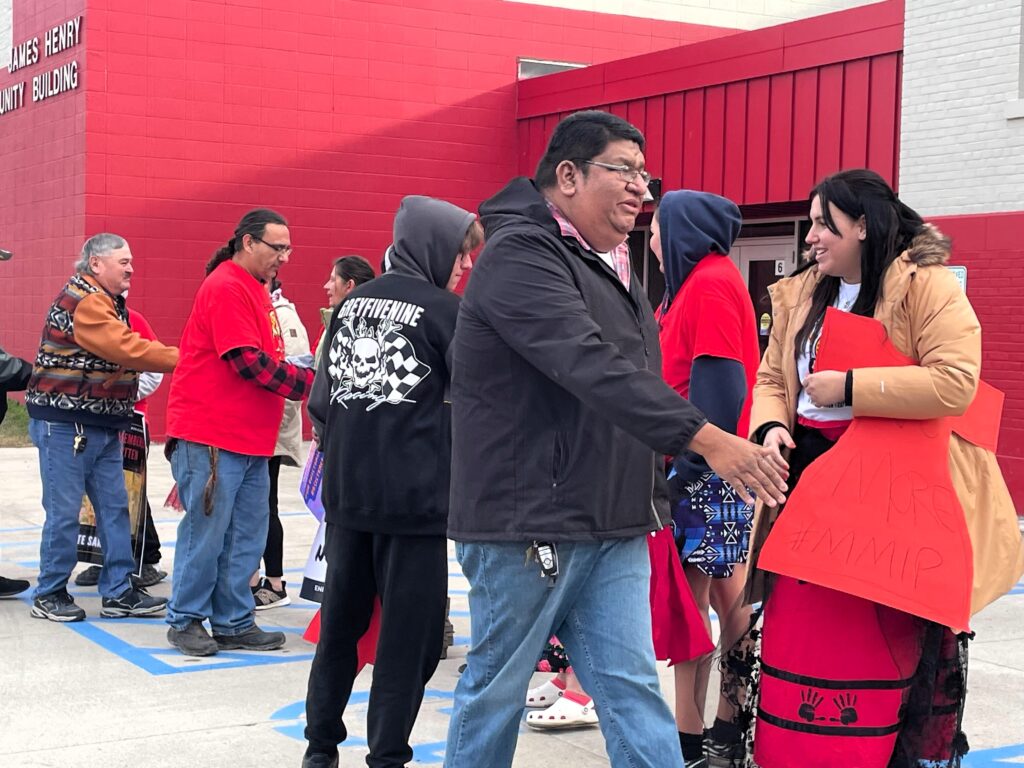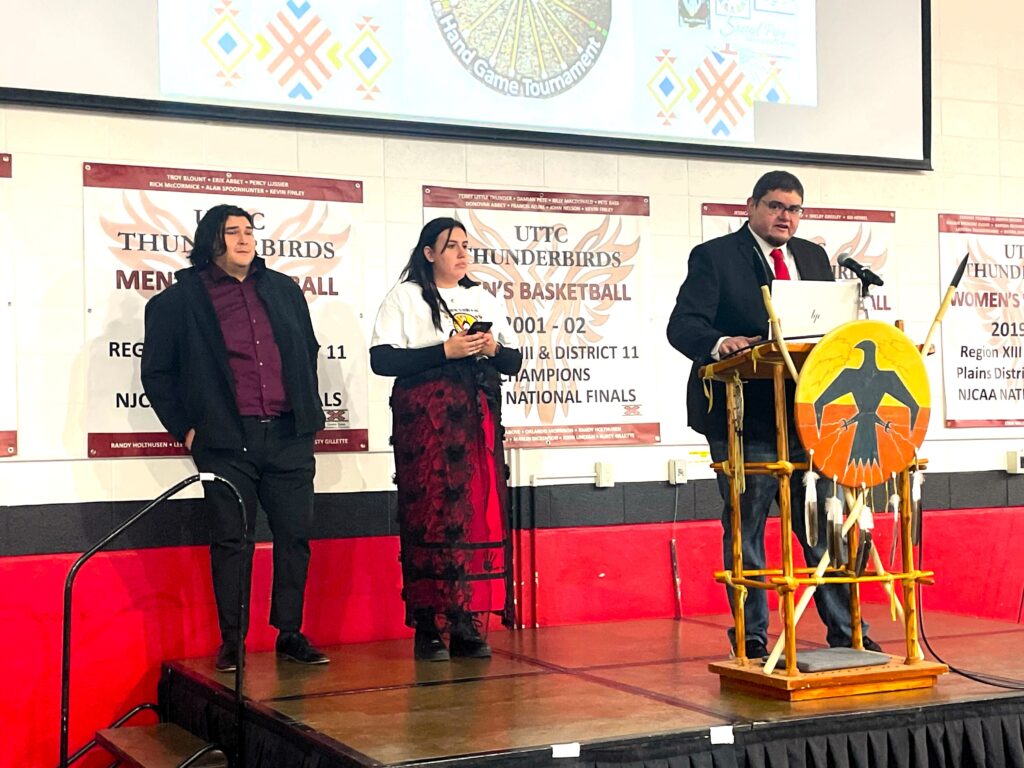News Based on facts, either observed and verified directly by the reporter, or reported and verified from knowledgeable sources.
North Dakota Natives unite to protect youths, women and men from violence, murder and rape
 Friends and family of Missing and Murdered Indigenous Relatives walked for a mile and a half to spread awareness during the Human Trafficking Walk on Nov. 30. Photo credit/ Adrianna Adame
Friends and family of Missing and Murdered Indigenous Relatives walked for a mile and a half to spread awareness during the Human Trafficking Walk on Nov. 30. Photo credit/ Adrianna Adame
Local nonprofit identifies 20 youth currently being trafficked in Bismarck
More than 30 people walked for a mile and a half in the cold and wind during the afternoon of Nov. 30, holding signs with the names of loved ones lost to violence, calls for justice and cutouts of women in red to demand more attention and resources to the issue of Murdered and Missing Indigenous Peoples.
The Human Trafficking Awareness Walk from Sacred Pipe Resource Center to United Tribes Technical College featured the families of victims such as Alex Vazquez, Jacob Thomas American Horse and Bryanna Rayne Ducheneaux-Clown.
Vazquez, then 24, went missing from American Horse Creek in Kyle, S.D. in 2015. Two other young people, Ducheneaux-Clown and American Horse, died in October and November.
“We’re just enduring the elements that the missing and murdered felt,” said Ahiticia Tasso, a student at UTTC and one of the founders of Maza LLC. “I truly believe that we have to suffer in a way that our ancestors did, in a way that our relatives had and in a way that people who are missing experienced.”
“I think it’s important to remind people that Indigenous people are one of the most missing and murdered of the ethnicities.”
Dominque Miner, a pre-engineering student at UTTC
Tasso noted there were fewer men than women who attended the walk. He called for American Indian men in the community to walk alongside the women, pointing out MMIP is an issue that affects all Indigenous peoples.
According to the Bureau of Indian Affairs, approximately 1,500 American Indian and Alaska Native missing persons have been entered into the National Crime Information Center. NCIC, with another 2,700 cases of Murder and Nonnegligent Homicide Offenses, according to the federal government’s Uniform Crime Reporting, UCR, Program. The BIA reports approximately 4,200 missing and murdered cases have gone unsolved.
Colonization, historical trauma, racism and sexual objectification of Indigenous women and girls contribute to the root causes of MMIP, according to a 2020 report conducted by the Wilder Foundation. Drugs also play a major role in MMIW, said Amy Boyd-Bolme, a program manager of the human trafficking program at Youthworks of North Dakota, a nonprofit that helps shelter vulnerable children and young adults.
Youthworks provides services such as individual counseling and transportation, as well as various emergency shelter and transitional housing options for clients. Over a year, the nonprofit typically serves around 160 youth who are suspected of being trafficked. In the last few years, Boyd-Bolme said they identified 20 youth in the Bismarck area who are actively being trafficked.

“Our girls are missing,” said Boyd-Bolme. “What it looks like for our Native girls is that they are being targeted by those who are selling drugs, they are using those people to help them sell drugs.”
The Indigenous girls and women who go missing are often disregarded or ignored when they do reach out for help. Finding ways to prosecute traffickers often proves challenging, as survivors are often afraid of reaching out for help and there is difficulty identifying the traffickers, according to the National Institute of Justice.
“They are used to being judged as girls who are making bad decisions, girls who are problems and girls who are promiscuous,” said Boyd-Bolme. “The reality is they have probably experienced sexual abuse from the time they were very young.”
More than 43% of American Indian and Alaskan Native women have been raped in their lifetime, according to the Center for Disease Control and Prevention’s 2017 National Intimate Partner and Sexual Violence Survey. Homicide was reported to be one of the top 10 leading causes of death for Native women in 2020.
“What it looks like for our Native girls is that they are being targeted by those who are selling drugs, they are using those people to help them sell drugs.”
Amy Boyd-Bolme, a program manager at Youthworks of North Dakota
Pauletta Red Willow, the director of Maggie’s House, a facility for youth who have aged out of the foster care system, said the lack of a safe space or support for Indigenous youths further puts them at risk of becoming a victim of MMIP. “This isn’t just an ‘us’ epidemic –– this is a ‘we’ epidemic,” Red Willow said.
Many UTTC students attended the walk, including student body president Tanner Veo. While Veo was originally against the idea of the event being held at the end of Native American Heritage Month –– a time to celebrate Native resilience and pride — he knew how important this walk would be for the community.
“I have family members, and I believe every single one of them has been sexually assaulted,” said Veo. “I think that having that issue brought forward and acknowledged is really important to our people because it shows solidarity.”
MMIP affects the lives of not just the families, but communities off and on the reservation, said Dominque Miner, a pre-engineering student at UTTC. A few years ago, Miner’s cousin went missing in the winter. They didn’t find out about his murder until the spring, when they began finding parts of him throughout the reservation. “I think it’s important to remind people that Indigenous people are one of the most missing and murdered of the ethnicities,” Miner said.

Miner believes in the power of numbers –– if more people come out to these events to show their support, then more can be done to prevent human trafficking. Talking more about MMIP makes it less taboo, Veo added.
“One thing I’ve learned from talking to the students here on campus is that there’s a lot of shame when talking about this topic because sometimes it is within our community, and I think having that dialogue there to open it up, it’ll help bring awareness but also start addressing the issue,” Veo said.
Another key element to addressing human trafficking in Native communities is for North Dakota’s American Indian population to keep advocating for themselves. Red Willow is optimistic about change to come in the Bismarck-Mandan area.
“It’s really hard to have cultural pride in Bismarck because it’s not a progressive community yet, but the more vocal we are, the more present we are and the stronger we are as Native peoples –– they have to take notice,” Red Willow said.
Boyd-Come encourages others to be gentle and kind to the girls and women who do approach them for help. Eventually, she wants there to be a multidisciplinary team on Standing Rock that could work with her team in Bismarck.
“What I would ask for people to do is get involved and to put respectful pressure on your communities to develop a human trafficking response,” Boyd-Bolme said.
Dateline:
BISMARCK, N.D.
